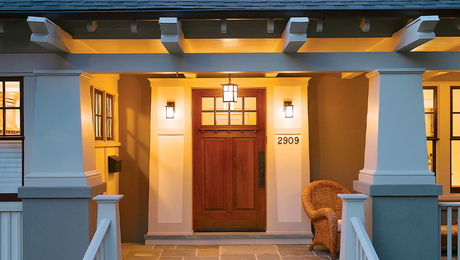I plan on building a 2-story ICF house with a basement in Michigan. There will be a front porch that takes up the whole front face of the house and sticks out around 5 feet. In addition there will be a roof overhang over the whole porch that will be supported by the porch. I was thinking the porch would be wood construction with a concrete stem wall to support it. The idea behind using a concrete stem wall is so that a stone facade could be put on the side of it. My question is how the footings for this stem wall would look. Can I just go down 42 inches or would they need to be the same depth as the basement footings? If they only need to go down 42 inches, can the footings and the stem wall be poured right up next to the ICF wall of the house? I’m assuming the wood framing of the porch could be supported on the one end by a ledger board bolted to the exterior of the house. I have a similar question for a sunroom I have planned that does not have a basement underneath it. The whole house is on a relatively flat grade and the basement footings would go down around 8.5 feet.
Discussion Forum
Discussion Forum
Up Next
Video Shorts
Featured Story

Lighting up an exterior isn't just about ambiance— it's also about code compliance. Here is what the code says about safety and efficiency when it comes to outdoor lighting.
Featured Video
SawStop's Portable Tablesaw is Bigger and Better Than BeforeHighlights
"I have learned so much thanks to the searchable articles on the FHB website. I can confidently say that I expect to be a life-long subscriber." - M.K.
Fine Homebuilding Magazine
- Home Group
- Antique Trader
- Arts & Crafts Homes
- Bank Note Reporter
- Cabin Life
- Cuisine at Home
- Fine Gardening
- Fine Woodworking
- Green Building Advisor
- Garden Gate
- Horticulture
- Keep Craft Alive
- Log Home Living
- Military Trader/Vehicles
- Numismatic News
- Numismaster
- Old Cars Weekly
- Old House Journal
- Period Homes
- Popular Woodworking
- Script
- ShopNotes
- Sports Collectors Digest
- Threads
- Timber Home Living
- Traditional Building
- Woodsmith
- World Coin News
- Writer's Digest


















Replies
Footings need to rest on undisturbed earth. You might have that 5 ft. out from the house, so you could use a 42 in. deep footing there, but the return walls would almost certainly need to go all the way down.
Are you planning to do the work yourself?
Stepped footers are not uncommon. every house with a basement and attached garage at grade level has a couple.
the principal is that footers have to be on undisturbed (or properly prepared (meaning compacted and selected) soils.
The footer under the walls that you mostly bury only need to be below the frost depth.
You can handle the transition from the bottom of the basement wall a couple ways. You could finish the basement, backfill while paying attention to properly compacted and selected material to support the higher footings. Then pour footings just below the frost depth.
You can also extend the basement footer where the other walls will be and build up the first foot or so of foundation wall close to the basement wall there, adequately bridging to the higher footer at or below 42 inches deep.
You will want to secure the porch and sunroom foundation to the concrete/steel inside the basement wall ICF.
Thanks for the replies!
Mike, when you say: "You will want to secure the porch and sunroom foundation to the concrete/steel inside the basement wall ICF." is there a way around this? I am concerned about the thermal bridging there would be if the uninsulated porch foundation is in contact with the ICF concrete wall. Would I have to do a free standing porch with 4 foundation walls in order to avoid this?
it would seem that the end walls are not bearing any load but are only there to support the stone veneer. I'd make them 42" deep on compacted fill. Run some threaded rod through the ICFs into the stem wall. You could use rebar, but I think the plated rod would be better through the foam. Is there going to be stone over the ICFs?
If the concrete stem wall is supporting the loads of the porch and the roof, besides the undisturbed earth consideration, I would think your engineer will be requiring your footings to be sized and their depth determined by their zone of influence not interfering with the house's foundation...Everything anywhere near another footing my engineer has spec'd as either bearing at the same level of the existing footing, or located and deep enough to not intersect the existing wall at the 45 degree from the bottom of the new footing.